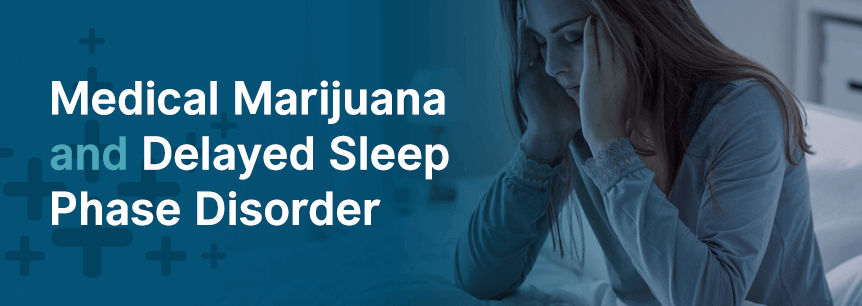
Sleep disorders, including delayed sleep phase disorder (DSPD), are conditions that medical cannabis can be particularly helpful for. Because it impacts your sleep, DSPD can affect your quality of life negatively. Symptoms such as insomnia, an inability to fall asleep and excessive daytime sleepiness — all often experienced by people with delayed sleep phase disorder — can be managed with medical marijuana. Learn more about DSPS, its symptoms and how medical marijuana treatment can help.
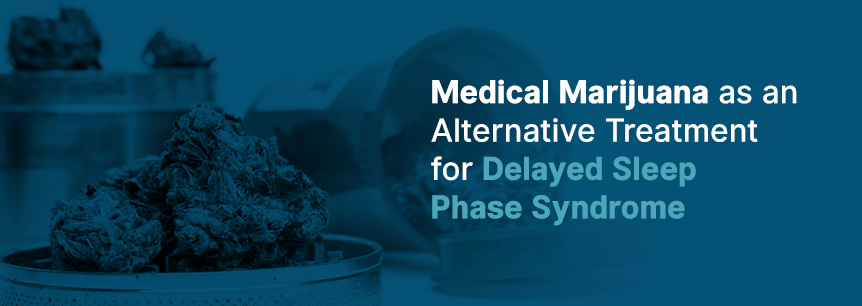
Before we go into how medical marijuana treatment for delayed sleep phase disorder can benefit you, we’ll first see how cannabis interacts with our bodies.
For centuries, marijuana has been used medicinally to treat nausea and pain as well as relieve mood problems like anxiety and depression. In the mid-1960s, researchers identified the initial cannabinoid. Since then, they have conducted further research, identifying over 80 individual cannabinoids. Today, researchers continue to investigate these cannabinoids for their possible disease-fighting and symptom-relieving abilities.
Out of the hundreds of various compounds in the cannabis plant, a few have been of particular focus in studies for decades for their potential therapeutic benefits. These compounds, called cannabinoids, are now used in treating a whole range of symptoms and conditions from pain and sleep to inflammation and anxiety, to cancer and Parkinson’s disease.
The two most common cannabinoids are:
Cannabinoids have numerous potential uses, including helping with pain, anxiety, stress and sleep problems. They affect the CB1 and CB2 receptors in the endocannabinoid system (ECS), which is spread throughout the body and brain.
Researchers have made a great deal of progress in their knowledge and understanding of how CBD produces pain-reducing, anti-inflammatory and calming effects in the body. Scientists know CBD interacts with many various proteins, receptors and other chemicals in the brain. The CBD interactions generate changes in the activity of hormones, neurotransmitters, and other cells. Through these interactions, CBD seems to have the ability to affect many functions of the body from emotional regulation and sleep-wake cycles to pain perception, inflammation, and seizures.
Your body also produces its own cannabinoids as part of your ECS. This ECS regulates many physiological processes, including:
Studies into medical weed and insomnia show CBD might have potential therapeutic benefit for treating insomnia. THC might reduce how long it takes you to fall asleep short-term, but long-term use could potentially impair quality of sleep.
Research into the investigation of cannabinoids and the sleep disorder obstructive sleep apnea show synthetic cannabinoids like dronabinol and nabilone might provide short-term benefits for sleep apnea because of their regulating effects on serotonin-mediated apneas. CBD could be promising for excessive daytime sleepiness and REM sleep behavior disorder.
Marijuana for delayed sleep phase disorder could potentially help treat these and other symptoms of the condition:
Because the herb can help eliminate stress and physically relax, it shouldn’t surprise you marijuana could help you fall asleep quicker, particularly for those treating insomnia and conditions like delayed sleep phase syndrome which interfere with your ability to fall asleep as medical weed relieves many troublesome symptoms. It’s worth taking note, marijuana-infused edibles’ effects can last a few hours, helping you stay asleep longer, however, they do take longer to take effect.
Marijuana strains known for promoting sleepiness include:
Medical pot can be a magnificent sleep aid and is why a lot of consumers have their favorite strain right by their bedside. Even individuals with stubborn insomnia can fall asleep with a nice sedating indica. Indica strains seem to induce stronger, sleepy effects when compared with sativas, which are energizing and uplifting.
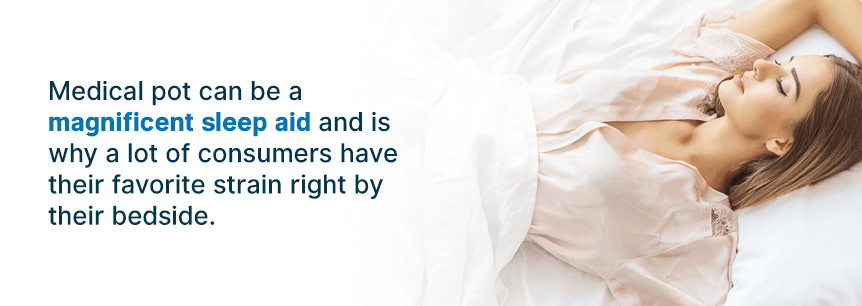
Marijuana strains to try for insomnia are:
A 2006 study tested CBD effects on animal models in both lights-off and lights-on environments. The researchers found the CBD compound increased alertness when the lights were on and didn’t have any discernable effects when the lights were off. The researchers of the study concluded CBD could have therapeutic promise for individuals with excessive daytime sleepiness from not being able to get a good night’s sleep.
A decent daytime strain will allow you to function all day long. A good daytime strain’s top qualities are its mind-clearing, energizing, focus-enhancing and mood-lifting.
Strains that could help with excessive daytime sleepiness are:
Depression and anxiety are mental abnormalities that affect people in various aspects of life, including health, productivity, and social life. CBD offers great psychiatric potential.
The goal of one study was to review animal model studies involving the use of CBD as an antidepressant-like and anxiolytic-like compound. Researchers in the studies performed various experiments on anxiety- and depression-related conditions using the elevated plus maze (EPM), forced swimming test (FST) and Vogel conflict test (VCT).
The studies showed CBD had antidepressant and anti-anxiety effects in the animal models. CBD experiments also showed non-activation of CB1 and CB2 neuroreceptors. Many of the studies showed a good CBD interaction with the 5-HT1A neuro-receptor.
Good anxiety and depression strains to try are:
While medical marijuana treatment can supplement standard medicines and counter side effects, it can also have some of its own side effects such as:
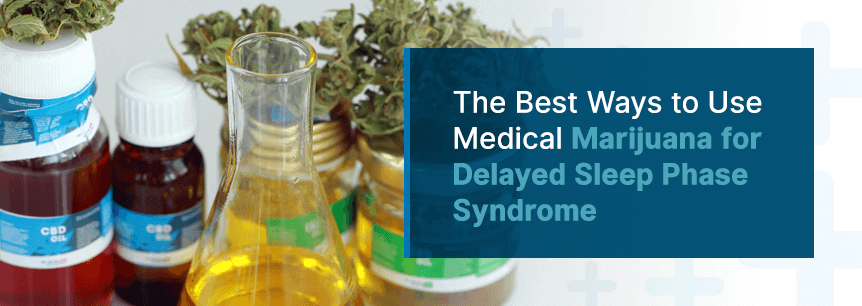
Most individuals ingest cannabis by smoking it with a pipe or as a joint. But smoking the herb can potentially harm your lungs, particularly for individuals with respiratory conditions like asthma.
If you prefer not to smoke because you want to protect your lungs, you can try vaporizers or tinctures, which you drop under your tongue. Each of these methods of using cannabis is ideal for sleep.
You may also want to try adding some of the herb to tea and drinking it before bed. Or, you can infuse cannabis in edibles and have a therapeutic bedtime snack.
The setting in which you use your treatment will affect your experience. A supportive and quiet environment is less likely to lead to anxiety and paranoia, which some users have experienced. You should note some individuals are more sensitive to cannabis’s effects and could have stronger reactions than others. Therefore, you’ll want to start with low doses and work your way up.
Finding a reliable dispensary and qualified cannabis doctor are two essential steps to beginning your marijuana treatment plan for delayed sleep phase disorder. A licensed, experienced medical weed doctor can recommend your treatment for you. Staff at a dispensary will have the proper knowledge to point you in the direction of the products you would benefit from the most.
The National Institutes of Health (NIH) describes delayed sleep phase syndrome as a circadian rhythm disorder affecting teens and young adults. Typical onset occurs between 10 and 20 years old. Many people between the ages of 18 and 25 reports having sleep difficulties.
A study conducted in Tottori, Japan, involving nearly 5,000 junior high, high school and university students determined the disorder has a prevalence of nearly a half of a percent among all students tested, almost a tenth of a percent amongst the youngest, and more than 1.5 percent prevalence amongst the oldest students tested. The American Sleep Association (ASA) suggests the numbers are much higher than the Japanese study indicates, with the condition affecting as many as 15 percent of adults and teens.
If you’re a student or young employee with delayed sleep phase syndrome (DSPS), it can be difficult for you to follow normal sleep patterns for waking and sleeping, resulting in difficulty for you to get up for school or at normal starting times.
While no exact medical cause has been pinpointed for causing delayed sleep phase disorder, a couple of prominent ideas about possible causes include:
1. Trauma to individual patients: DSPS is more common among patients who have experienced head traumas, like traumatic brain injury (TBI), or serious illnesses. The theory behind this is that your body’s natural attempts to heal itself may inadvertently disrupt the normal circadian rhythm in such as a way that your normal clock cannot “resync” without assistance.
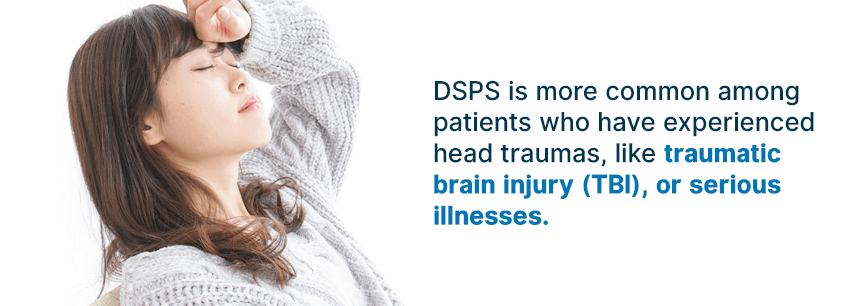
2. Lifestyle contributions: Another theory is that lifestyle considerations, such as participation in work-at-home jobs, late night gaming sessions, staying up late to complete homework and study for exams or artistic careers that involve irregular work hours may contribute to DSPS.
Some people who have delayed sleep phase disorder may appear simply to stay up too late and have correlating issues getting up in the morning. For others, it’s a matter of being unable to sleep at what would otherwise be considered the normal times, sometimes requiring additional hours before they can finally fall asleep.
The following are some of the other symptoms you may experience if you have delayed sleep phase disorder:
Because it mimics the symptoms of other conditions, physicians can have trouble accurately diagnosing delayed sleep phase syndrome. As a result, patients are often misdiagnosed with ADHD, depression and other behavioral problems resulting from the excessive daytime sleepiness DSPS causes rather than being correctly diagnosed.
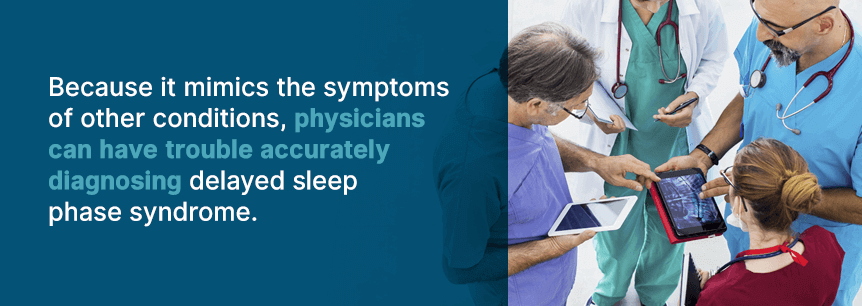
Other potential complications arise from failing to diagnose other potential causes of the sleep problems that could include any of the following:
It’s important to work with your physician or to rule out other conditions you may have and to identify other possible causes of your sleeping issues before zeroing in on delayed sleep phase disorder.
Physicians and sleep specialists use several treatments to help address delayed sleep phase disorder and get the body’s circadian rhythm back on track. These include the following:
With this type of treatment, you’re exposed to very bright lights shortly after waking each morning and avoid bright light exposure during evening hours. This includes going out for a walk in the sunshine early in the morning and avoiding computers and other bright lights — or using nighttime settings that offer dimmer lighting — before going to bed at night.
“Sleep hygiene” refers to your bedtime routine, including the things you do in the 30 minutes to one hour before going to bed. Following a pattern of behavior cues your body and your brain that it’s time to begin the process of shutting down for the night, making it easier to go to sleep. Better sleep hygiene includes you:
Some people swear by melatonin for restoring natural circadian rhythms. The best idea is to work with your doctor and seek their advice before taking melatonin or other sleeping aid, especially if you are taking other medications to promote sleep.
If you’re struggling with symptoms of delayed sleep phase syndrome and would like to know if medical marijuana for delayed sleep phase disorder is right for you, search through Marijuana Doctors to find a qualified cannabis doctor and book your appointment.
Find A Doctor Find A Dispensary